|
2004/05 – 2006/07 SERVICE PLAN
Ministry of Community, Aboriginal and
Women's Services
Goals, Objectives, Strategies and Results
During the next three years the Ministry of Community, Aboriginal and Women's Services will be working towards the goals and objectives discussed below. These goals and objectives are consistent with the Ministry's vision of "safe, sustainable, liveable and healthy communities."
Results, key strategies and performance measures are also identified. Development and refinement of performance measurement is ongoing, particularly since many measures are relatively new.
The Ministry's eight goals are summarized below and discussed in detail in the pages that follow.
| Core Business |
Goals |
| Local government |
1. Local governments are open, accountable and effective |
| Housing, Building and Safety |
2. Housing needs and safe building standards are met
3. Loss of life, injury and property damage are minimized in the built environment |
| Aboriginal, Multiculturalism and Immigration |
4. Social and economic outcomes for Aboriginal people are improved
5. The social and economic benefits of immigration and multiculturalism are maximized |
| Women's Services, Seniors and Child Care |
6. Women's and seniors' unique social and economic needs are addressed
7. The child care system is sustainable and meets the needs of British Columbia families |
| Executive and Support Services |
8. Support services enable Ministry programs to be effective and dynamic |
This section of the service plan presents performance information for each goal and business area, including the following elements:
- Goals
The long-term result that the Ministry wants to achieve to fulfill its vision and mission.
- Objectives
These elaborate on the goals and provide more specific direction for the Ministry. Objectives are to be achieved within the period of this service plan.
- Strategies
These activities are key program priorities over the next three years and will help the Ministry achieve its objectives.
- Performance Measures and Targets
This service plan includes two types of performance measures: outputs and outcomes. Output measures reflect a program's level of service or activity. Outcome measures indicate how successfully program activities and outputs have delivered results.
Performance measure tables include targets for the next three years for key output and outcome measures. Keeping the performance measures to a limited number is a challenge given the many lines of business. The full success of many programs cannot be demonstrated with a single definitive measure. Therefore, performance measures in this service plan paint only a high level picture of what the Ministry plans to achieve. Each branch or division has its own service plan including multiple performance measures. Accountability for these results is monitored internally.
Finally, some performance measures used in last year's service plan have been replaced with new measures. This is an expected part of the evolution of performance management in the Ministry. Where performance measures have been changed or replaced, an explanation is provided.
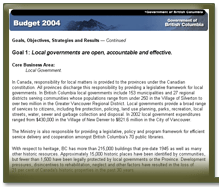 |
 |
Goal 1: Local governments are open, accountable and effective. |
 |
 |
 |
 |
 |
 |
 |
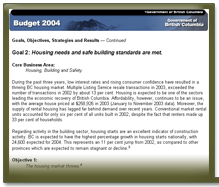 |
 |
Goal 2: Housing needs and safe building standards are met. |
 |
 |
 |
 |
 |
 |
 |
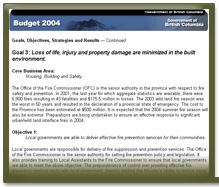 |
 |
Goal 3: Loss of life, injury and property damage are minimized in the built environment. |
 |
 |
 |
 |
 |
 |
 |
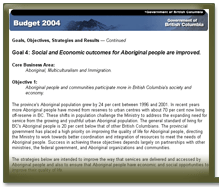 |
 |
Goal 4: Social and Economic outcomes for Aboriginal people are improved. |
 |
 |
 |
 |
 |
 |
 |
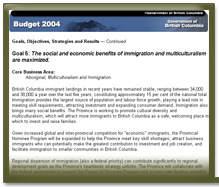 |
 |
Goal 5: The social and economic benefits of immigration and multiculturalism are maximized. |
 |
 |
 |
 |
 |
 |
 |
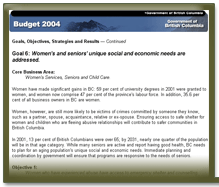 |
 |
Goal 6: Women's and seniors' unique social and economic needs are addressed. |
 |
 |
 |
 |
 |
 |
 |
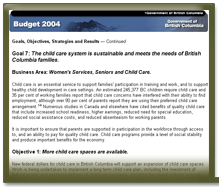 |
 |
Goal 7: The child care system is sustainable and meets the needs of British Columbia families. |
 |
 |
 |
 |
 |
 |
 |
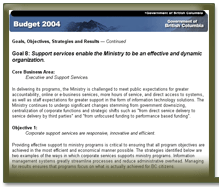 |
 |
Goal 8: Support services enable the Ministry to be an effective and dynamic organization. |
 |
 |
 |
 |
 |
 |
 |
Related Initiatives
Enterprise-Wide Risk Management
The Ministry of Community, Aboriginal and Women's Services has undertaken a process to enhance risk management by demonstrating that all "Ministry of Community, Aboriginal and Women's Services executive and managers proactively identify and manage opportunities and risks."
To this end, the Ministry is changing its culture through a common language and structured approach to risk management. This approach has included:
- analysis of risks to achieving ministry objectives at the executive level;
- training for ministry executive and management staff on risk management;
- development of guidelines and resource materials on risk management;
- briefing of ministry management on risk management as it relates to service planning; and
- full integration of risk analysis in all branch and departmental service plans.
With these steps, the Ministry has significantly evolved its risk management processes to attain compliance with Core Policy Manual Chapter 14, Risk Management, by March 31, 2006.
| Performance Measure |
Baseline |
Target |
| 2004/05 |
2005/06 |
2006/07 |
| Output: Proportion of branches/departments formally undertaking risk analysis as part of planning process |
Risks and efforts to overcome risks considered in 100 per cent of service plans |
100% or
25 of 25 |
100% |
100% |

Deregulation
The Ministry of Community, Aboriginal and Women's Services is contributing to the government-wide New Era commitment to cut red tape and reduce the regulatory burden by one-third within three years. As part of the initiative, in 2001, the Ministry completed a baseline count of 71,238 regulatory requirements.
On January 31, 2002 the Ministry completed three-year deregulation plans and is working to implement them through streamlining, modernizing and harmonizing its legislation, regulations and policies. In 2002/03, the Ministry achieved a 14 per cent reduction in regulatory requirements.
In 2004/05, the Ministry will achieve a 37.1 per cent cumulative target reduction in regulatory burden.
Throughout 2005/06, the Ministry will maintain this target and continue to review new opportunities for reductions and "smart tape." It will continue to comply with the Regulatory Reform Criteria and the Regulatory Reform Policy to demonstrate its commitment to controlling regulatory burden and ensure regulatory quality.
- Performance Measure:
- Reduction of Ministry's regulatory burden by one-third by 2004.
| Performance Measure |
Baseline |
Target |
| 2004/05 |
2005/06 |
2006/07 |
| Per cent of regulations eliminated |
Total 35.1% reduction |
2%
Total 37.1% reduction |
Review new opportunities for reductions and
"smart tape" |
Review new opportunities for reductions and
"smart tape" |
Climate Change
The Ministry supports work on climate change through the following initiatives:
- Canada/BC Energy Efficiency Projects;
- partnering on a policy review of energy performance for buildings;
- working with the Ministry of Water, Land and Air Protection and local governments to encourage more energy efficient building practices; and
- developing options for strategic use of Local Government Infrastructure Grants to include climate change initiatives.
|









